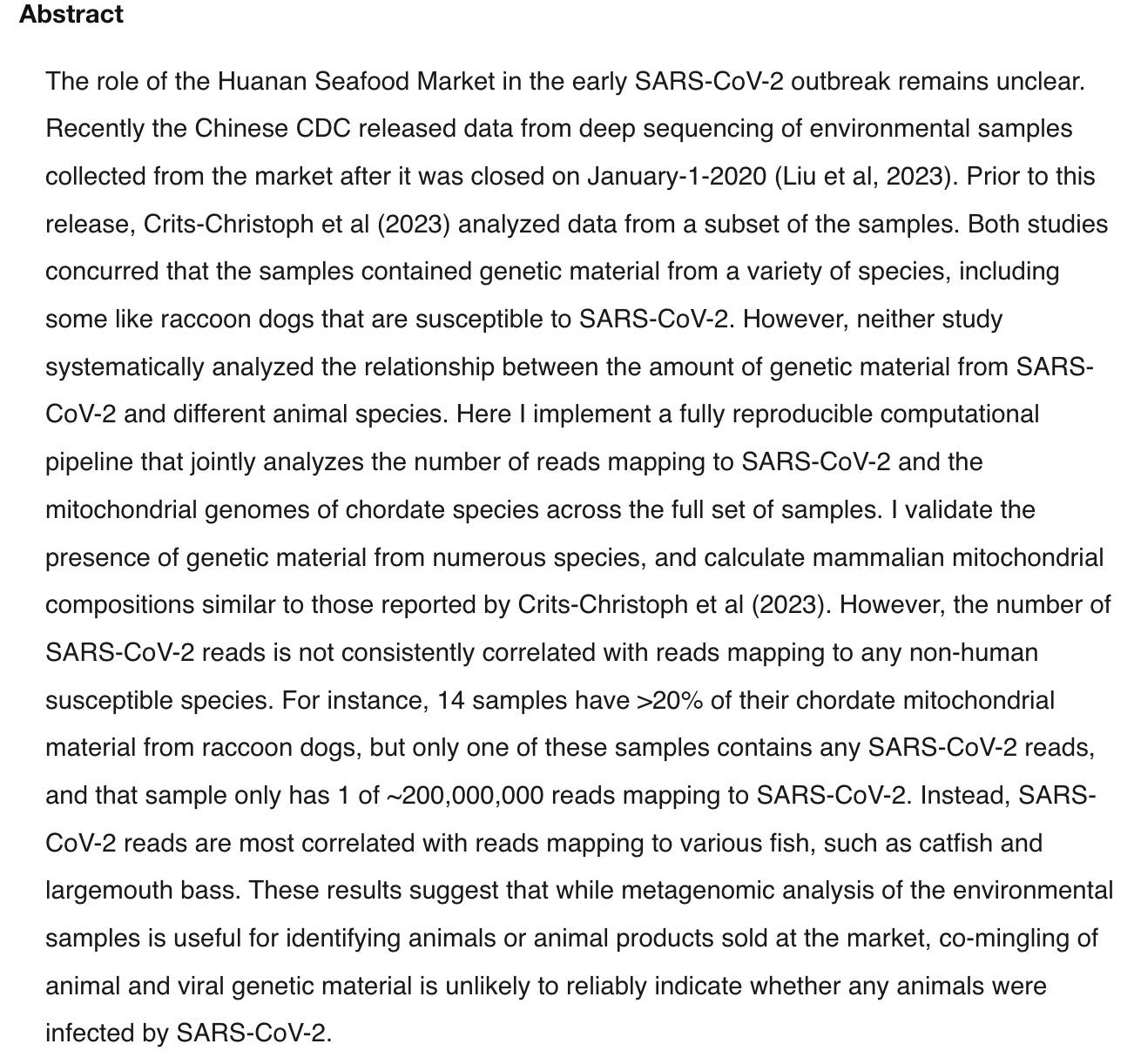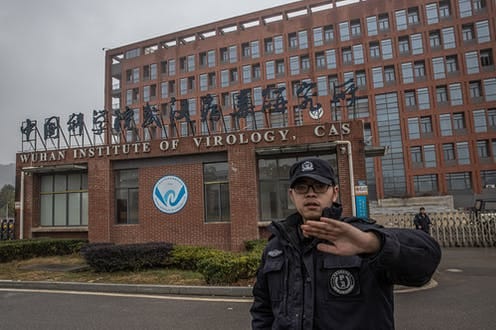Raccoon dogs exonerated
Numerous media accounts had told us scientists had linked the pandemic's origins to raccoon dogs sold in a Wuhan market. But a new study by a noted virologist finds only a negative correlation.
For the past day, I have been debating with myself whether to put a question mark on the title of this post. No scientific findings are definitive, and when it comes to the origins of the Covid-19 pandemic, scientists simply do not agree whether it was caused by a zoonotic spillover or a research-related accident of some kind.
Nor, unfortunately, is it easy to find a scientist who does not have a (raccoon) dog in the fight, as it were. Passions run high, for the simple reason that there is a lot at stake in knowing how a pandemic that has caused more than 1 million deaths in the U.S. and at least 14 million (probably more) in the world got started. Add to that the severe politicization of the issue and we’ve got a real epistemological mess on our hands.
For the general public, which is whipsawed nearly every week (sometimes daily) with headlines declaring that one or the other hypothesis has won out, the whole debate must be very confusing (except, of course, for those who have already made up their minds; in the U.S., the so-called “lab leak” hypothesis is winning in public opinion polls.)
Last month, we were treated to blazing headlines announcing that an “international team” had found what The Atlantic called “The Strongest Evidence Yet” that the pandemic began at the Huanan Seafood Market in Wuhan, and that raccoon dogs (a species closely related to the fox) had transmitted the virus to humans. Despite worldwide media hype of this alleged finding, the story quickly began to fall apart—or at least the certainty that it was true. The mainstream media, which has been strongly biased in favor of the zoonotic spillover hypothesis since the beginning of the pandemic—after all, that is the scenario favored by Dr. Fauci—nevertheless failed to keep up with developments.
One scientist who questioned the raccoon dog story, initially in a Twitter thread, was Jesse Bloom of the Fred Hutchinson Cancer Center in Seattle. Bloom, who is variously described as an evolutionary virologist or a computational virologist, has never offered an opinion one way or the other on Covid-19 origins. That means that members of the so-called “Zoo Crew” or “Zoonati” (as they are often called by the rival group, known as the “Lab Leakers”) have to treat Bloom with respect, as of course they should. And he is particularly respected by Lab Leakers, because over the course of the pandemic he has often questioned the strength of the evidence for zoonosis, while never discounting it as a possibility.
A continuing theme for Bloom has been the issue of missing and deleted data that could help us solve the mystery of Covid-19 origins, and the near certainty that there were cases in Wuhan at least as early as November 2019—making the December 2019 cases that China reported to WHO, which have formed the basis of the most-cited peer reviewed papers in favor of zoonosis, open to serious critiques.
Now, in a study dated April 25 but apparently not posted as a preprint until late in the evening on April 26, Bloom has done a deep dive into the metagenomic data that supposedly pointed the finger at raccoon dogs as the long-sought intermediate host between bats and humans, and that allegedly allowed the SARS-CoV-2 virus to jump the species barrier.
First let’s define metagenomics, or let the National Human Genome Research Institute define it:
“Metagenomics is the study of the structure and function of entire nucleotide sequences isolated and analyzed from all the organisms (typically microbes) in a bulk sample. Metagenomics is often used to study a specific community of microorganisms, such as those residing on human skin, in the soil or in a water sample.”
As you may recall from previous coverage, after the pandemic broke out in Wuhan in December 2019 or earlier, a number of cases were linked to the Huanan Seafood Market in Wuhan (although, importantly, they were not the earliest cases.) Beginning January 1, 2020, a team of scientists from China’s CDC (led by its former director, George Gao, who has figured heavily in more recent events) began taking samples from the market, which the authorities had shut down. The results of genetic sequencing of those samples, which were only made publicly available very recently in connection with a paper the CDC team published in Nature, are at the heart of the raccoon dog story.
They are also the subject of Bloom’s new analysis. For those who might prefer not to read on as I go into the details, or who want to read the rest of this later, let me post the abstract to the preprint so you will at least have the takeaway message:
Spoiler alert: In the study, Bloom concludes that the pandemic virus is not only not correlated with raccoon dog DNA, but is actually negatively correlated. The most positive correlation is with fish such as catfish and largemouth bass (the Huanan market was not called a seafood market for nothing.)
Let’s go through some of the major points in the Bloom study. I will number them to make it easier to follow (for me as well!)
There is no dispute that human cases of Covid-19 began appearing among customers and vendors at the Huanan market by mid-December 2019, and that animals susceptible to being infected by the SARS-CoV-2 virus—including raccoon dogs—were being sold there.
The Chinese scientists never previously reported a quantitative metagenomic analysis of the data from the market, but when they finally uploaded it to an international database the data came to the attention of what the media called an “international team” of scientists. (MB: Most media accounts did not reveal that the team was made up almost entirely of well-known proponents of the zoonosis hypothesis.)
The news of the international team’s unpublished and unposted analysis of the raw data leaked to the media (The Atlantic, New York Times, and Science on the first day, around the world by the second.) The media accounts (prompted by the comments from members of the international team), underscored that there was co-mingling of raccoon dog DNA and the SARS-2 virus in at least one sample (sample Q61.)
The international team did not report on how much virus was in the samples. When the Chinese team published the Liu et al. paper in Nature, it became clear that most of the raccoon dog DNA was found in samples that were negative for the virus.
Bloom set about to quantify these relationships, first by creating what is called a bioinformatics or computational “pipeline,” that is, a sequential series of sequence analyses, strung together like beads on a string. (With thanks to biologist Steve Massey of the University of Puerto Rico for the definition.) Using this pipeline, Bloom was able to analyze the Chinese data, which amounted to more than three terabytes of data (trust me, that is a huge amount.)
Bloom confirmed many of the findings of the international team, which had focused only on mammal metagenomics, but expanded the analysis to include other chordates (basically, animals with some kind of stiff rod down their backs, whether it be the backbone of a fish or the spine of a mammal.)
Surprisingly, despite the huge emphasis that has been put on the market as the supposed “epicenter” of the pandemic, most environmental samples (eg from food stalls, counters, sewers, other surfaces) had little or no SARS-CoV-2 genetic sequences (the Chinese team had earlier reported that no animals were found to harbor the virus.)
While raccoon dogs made up the largest proportion of mammalian mitochondrial DNA in the Q61 sample, when all chordates were included duck DNA was more prevalent.
Sample Q61, which was collected by the Chinese CDC on January 12, 2020 and was the focus of most of the media accounts, was dominated by raccoon dog and duck DNA; but it had only 1 out of a total of roughly 200,000,000 sequence “reads” that mapped to SARS-CoV-2. Moreover, out of 14 samples that had significant amounts of raccoon dog DNA, Q61 was the only one that had any virus at all.
Bloom comments: “…it takes a great deal of cherry picking… to put any plausibly infectable hosts at the top of the list of species whose mitochondrial material is most correlated with the abundance of SARS-CoV-2.”
In his discussion in the paper, Bloom tries to put his findings into a “larger context,” and I will quote that in full because it really is his bottom line:
“When considered in larger context, the inability of the environmental samples to inform on the origins of the virus is unsurprising. These samples were all collected on January-1- 2020 or later, which is at least several weeks after the Huanan Seafood Market became a superspreading site for human infections (Li et al. 2020). Therefore, by the time the samples were collected, SARS-CoV-2 had been spread widely across the market by humans regardless of its original source—as evidenced by the results reported here, which show viral genetic material coincident with material from myriad animals ranging from fish to snakes to mammals. The first human infections with SARS-CoV2 in Wuhan occurred no later than November of 2019 (ODNI 2022; Zhang et al. 2020; van Dorp et al. 2020; Pipes et al. 2021), which is over a month before the Chinese CDC reports that it began to collect samples from the market. For this reason, further insight into the origins and early spread of SARS-CoV-2 will likely require learning more about events or cases that occurred no later than November or early December of 2019.”
My own comment at this point, as Bloom also suggested in his Twitter thread about the findings, is that the media hype over the raccoon dog findings was unnecessary and unwarranted. Most reporters did not do the kind of in-depth reporting required to put the findings from the partisan “international team” into this kind of context, satisfying themselves with quoting scientists (almost all from the team) and leaving it at that.
I am also surprised that neither the international team nor the Chinese team did this kind of metagenomic analysis, given that the data was available to do it. Perhaps the peer reviewers at Nature should have required Liu et al. to do this; after all, the paper was in peer review for more than a year before it was published.
The lead author of a preprint the international team posted after the initial media blitz, Alex Crits-Christoph, has now responded to the Bloom study on Twitter. Here is a thread reader version of what he had to say. While Crits-Christoph says their analyses agree in large part, he makes several objections, most notably that Bloom eliminated samples that had less than 20% of their chordate mitochondrial DNA from raccoon dogs, a technical decision explained in the paper.
I asked a few scientists favorable to the lab origins hypothesis to respond to the Crits-Christoph commentary. Justin Kinney, an expert in how cells control their genes at the Cold Spring Harbor Laboratory in New York state, said the following:
“I don’t think the 20% cutoff is a big issue. The biggest issue is that there was only 1 {SARS-2] read in Q61, and that 1 single molecule was the entire basis for the ‘raccoon dog started the pandemic’ interpretation of their results (an interpretation they promoted in their media blitz, though they never explicitly said this). The fact that Bloom finds a negative correlation between raccoon dog and [SARS-2] material underscores the absurdity of the interpretation.”
On Twitter, Kinney expressed his anger—shared by many other scientists and journalists—at how the raccoon dog story had been hyped by the Crits-Christoph team, whose members spoke freely to the media about it:
Steven Massey, a biologist at the University of Puerto Rico, agreed with this overall critique. Some weeks back, Massey had begun posting a series of Twitter threads giving his own analysis of the weaknesses in the raccoon dog story. You can find them here, here, here, and here. Using somewhat different methodology, Massey (in collaboration with some other scientists) came up with results similar to those Bloom posted this week.
The bottom line is that, as I have written earlier, there is simply no direct evidence for the zoonosis hypothesis. There is evidence that some might consider circumstantial, but the same can be said for the lab origin hypothesis.
But will the media, which gave the raccoon dog story so many headlines, now cover the Bloom preprint, as it has routinely done with unpublished work supporting the zoonosis hypothesis? As I write, nearly 48 hours after Bloom went online with his study, I have only seen one story, from Sarah Knapton at the Daily Telegraph, reporting on his analysis. Perhaps there are more to come…
While I personally am leaning towards lab origin at this point, I too do not have a raccoon dog in the fight. I just want to know the truth about what started a pandemic that has killed so many millions. And I think at some point soon we will have a pretty good idea about the truth, as the intelligence agencies begin to declassify their data and tell us what we really need to know to solve the puzzle of Covid origins:
What was going on inside China in the fall of 2019?
mmmm







